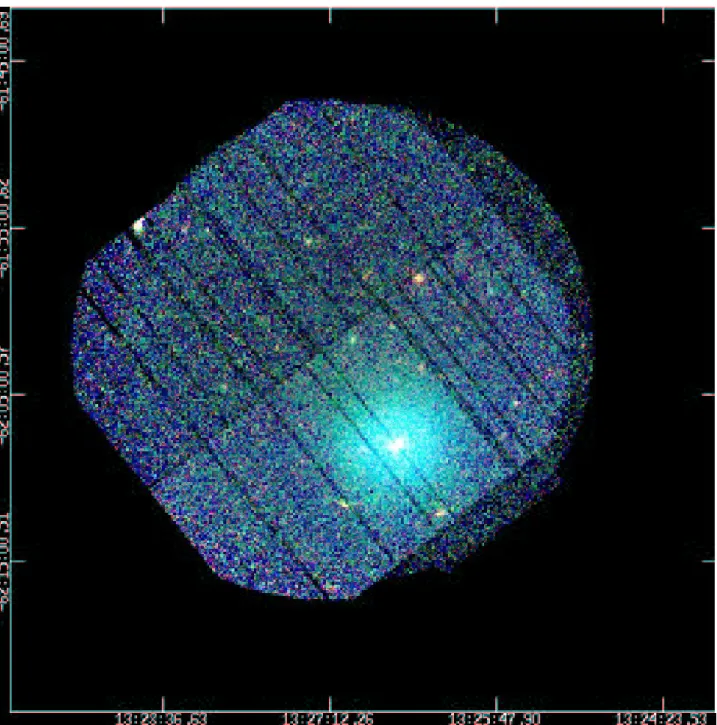Preliminary results of an observational
campaign aiming at the study of the binary
system LSS3074
∗
E. Gosset
1†, G. Rauw
1†, J. Manfroid
1‡, E. Antokhina
2,
I.R. Stevens
3and H. Sana
1§1 Institut d’Astrophysique, Universit´e de Li`ege,
All´ee du 6 Aoˆut, 17, Bat.B5c, B-4000 Li`ege, Belgium
2 Sternberg Astronomical Institute, Moscow State University,
Universitetkii pr., 13, 119899 Moscow, Russia
3 School of Physics and Astronomy, University of Birmingham,
Edgbaston, B15 2TT Birmingham, Great Britain
Abstract: We present preliminary results of an observational campaign aiming at the study of the binary system LSS3074. A new lightcurve clearly indicates that the system is in contact. Recent spectroscopy broadly confirms the previous results and the rather low masses of both components (O4f+ and O6-7:(f):). We further analyse an XMM-Newton observation of the object that indicates a rather hard X-ray spectrum. This is partly due to the high interstellar extinction towards the object but also to the high plasma temperature (kT ∼ 1.2-1.3 keV).
1
Introduction
LSS3074 is a short-period (P∼2.18 days) spectroscopic binary system situated in the Coalsack region. Being classified O4f+ + O6-7:(f):, it is a very interesting target since it harbours one of
the very few known O4f+ stars. These objects are rare since they probably represent a
short-lived transition phase in the evolution of massive O-type stars before they become Wolf-Rayet stars. An accurate determination of the mass is thus of the utmost importance. A first orbital solution was presented by Morrell and Niemela (1990) leading to rather low minimum masses around 8-9 solar masses. The first light curve was presented by Haefner et al. (1994) but they did not achieve a good phase coverage. Nevertheless, they proposed an inclination of the order of 50◦-55◦. Such an inclination suggests masses in the range 17-21 solar masses which remains
∗Based on data collected at the Cerro Tololo Inter-American Observatory and at the European Southern
Observatory (La Silla, Chile) as well as with the XMM-Newton Observatory, an ESA Science Mission with instruments and contributions directly funded by ESA Member States and by the USA (NASA).
†FNRS Research Associate (Belgium) ‡FNRS Research Director (Belgium) §FNRS Research Fellow (Belgium)
Figure 1: The observed instrumental V lightcurve (dots) of LSS3074 and the theoretical lightcurve (continuous line) of a similar system exhibiting pure ellipsoidal variations but no eclipse at all. Phase 0.0 corresponds to conjunction with the primary in front.
rather low. We acquired new photometry and new spectroscopy of the system and we also observed it with the XMM-Newton observatory. We describe here the preliminary results of this campaign.
2
Spectroscopy
Several spectra of LSS3074 were acquired at the Cerro Tololo Inter-American Observatory and at the European Southern Observatory at La Silla in Chile. The spectrum of LSS3074 is characterized by He i and He ii absorption lines and is also marked by strong interstellar lines (Ca ii, Na i, DIBs). A few lines exhibit strong emission (Hα, He ii λ 4686, N iii λλ 4634-4640, He i λ 5876). Weaker lines are also present in emission (Si iv λλ 4088-4116-6668, N iv λ 4058). Careful measurements of the positions of the absorption lines of the primary and secondary stars led to a new set of radial velocities. We derived a new standard orbital solution confirming the low value of the minimum masses. The total (a sin i) amounts to some 19.1 solar radii. The primary O4f+ turns out to be the less massive star. It is interesting to notice that the radial
velocity variations of the nitrogen emission lines follow the primary orbital movement.
3
Photometry
LSS3074 was monitored over two 15-day runs separated by 20 days without observation. The images were acquired with the Yale 1m telescope at Cerro Tololo equipped with the ANDICAM instrument. The daily rate corresponds to two or three well separated measurements per night. The photometry was performed in the Johnson BVRI system. In all the bandpasses, the lightcurves of LSS3074 are almost perfectly sinusoidal with an amplitude of about 0.18-0.20 mag., the two minima being essentially equal. This amplitude is rather difficult to explain by pure ellipsoidal variations of the system. In Fig. 1, we exhibit the V lightcurve and the
predicted amplitude of the variations due to the ellipsoidality of the components. It is necessary to invoke eclipses to explain the observed minima. The sinusoidality of the lightcurve linked to the necessity for the presence of eclipses rather suggests that the eclipse is large in phase to the point that the system must be in contact. From the fit of the lightcurve, an inclination of roughly 55◦ is derived and thus absolute masses of 16 and 19.3 solar masses for the primary and the secondary, respectively.
4
X-ray observation
LSS3074 was observed with the XMM-Newton observatory in August 2001. The exposure time for the EPIC-pn instrument was 22.8 ks. The EPIC field of view for the LSS3074 observation contains the low-mass X-ray binary (LMXB) XB1323–619 (see e.g. Boirin et al. 2005) which is outstanding in the image (see Fig. 2). LSS3074 is detected as a mildly hard source: it is the star at the centre of the field.
We have extracted the EPIC-pn spectrum of LSS3074. It is rather well-fitted with a one tem-perature optically thin plasma model of the mekal type: the derived temtem-perature is kT = 1.29 keV. A two temperature fit gives kT1 = 0.10 keV and kT2 = 1.23 keV thus confirming the 1.2
keV component. The source appears hard due to a combination of this rather high temperature and of a rather large absorbing column. The fitted models correspond to an ISM corrected flux funabs
X = 9 × 10
−14 erg cm−2 s−1 in the range 0.5-5.0 keV.
5
Conclusion
LSS3074 turns out to be a very interesting object whose evolution could have been heavily influenced by its binarity. The origin of its X-ray emission needs further study. All the details about the present campaign and the related results will appear in a future paper.
Acknowledgements
The Belgian authors are greatly indebted towards the Fonds National de la Recherche Scien-tifique for multiple support. They further acknowledge support from the PRODEX XMM and Integral projects as well as from the contracts P4/05 and P5/36 ‘Pˆole d’Attraction Interuniver-sitaire’ (Belgium). EA benefited from a support by the Russian Foundation for Basic Research (project No 02-02-17524) and by the Russian LSS (project No 388.2003.2)
References
Boirin L., M´endez M., Diaz Trigo M., Parmar A.N., Kaastra J.S., 2005, A&A, 436, 195 Haefner R., Simon K.P., Fiedler A., 1994, IBVS, 3969, 1
Morrell N.I., Niemela V.S., 1990, in Properties of hot luminous stars, A.S.P. Conf. Ser., 7, 57
Figure 2: Combined EPIC-MOS1, EPIC-MOS2 and EPIC-pn image in the 0.5-8.0 keV band. The LMXB star is outstanding. LSS3074 is the star at the centre of the field.

